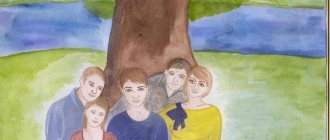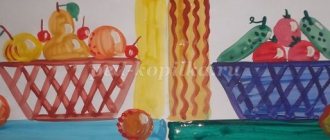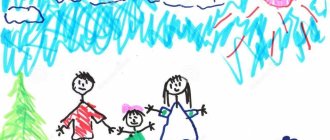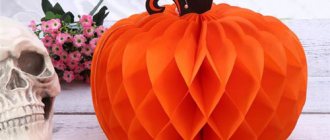November 29, 2016
Averyanova Sveta
A small child makes his first attempts to draw. He is interested in how to draw a squirrel with a pencil. You don't have to be an artist to help your child. There are special methods that allow you to quickly master the technique of depicting animals.
Using the step-by-step drawing method, you can easily depict any object on paper with a sufficient degree of similarity.
You can try to draw simple objects and animals (squirrel, fox, wolf, etc.) with a three-year-old child. Don't rush, don't criticize, and don't demand too much. If you criticize, your child may hate drawing.
Over time, if he is interested, the child himself will improve the technique of creating a drawing. With an older child, 5 or 6 years old, you can draw more complex drawings, for example, depict an animal on a tree. You can also start working with watercolors and gouache.
Drawing techniques in the middle group
At 4–5 years old, children practice both traditional and non-traditional drawing techniques.
Traditional painting techniques
As for classical techniques, in the middle group they are presented:
- drawing with a simple pencil - most often to indicate the contours of the image;
- drawing with colored pencils - children color the elements of the composition, trying to act exactly within the boundaries of the contours, while the direction of the strokes in the image of individual details does not change;
- drawing with wax crayons to obtain a rich color scheme of the picture;
- drawing with felt-tip pens - to practice coloring without going beyond the boundaries of the outline;
- drawing with gouache - not only for coloring pencil templates, but also for drawing the contours of animal images with paints;
- painting with watercolors - in particular, children practice multi-layered images, that is, they draw an element, let it dry, and then detail it with a different color (for example, they paint the body of a squirrel orange, and then draw the abdomen with yellow).
Photo gallery: examples of finished works in traditional techniques
In the drawing of a squirrel, children detail the face without first drawing contours
The drawing of the kids is done without a pencil outline; children show the boundaries of the image with lines made with a thin brush. In the middle group, drawings of animals in various poses are made from life
To depict the texture of a cat's fur, children sketch with small zigzag lines.
Felt-tip pens can be used to create drawings using non-traditional techniques, but they are rarely used in classical techniques, since they do not provide an opportunity for children to practice pressure force, as when working with pencils
Non-traditional drawing techniques in the middle group
In the middle group, drawings are practiced to depict wild and domestic animals using non-traditional techniques:
- with their palms, for example, when introducing the topic “Exotic Animals”, children draw a giraffe;
- poking with a semi-dry brush to depict animal fur;
- a fork for detailing needles or conveying the hard texture of an animal’s skin;
- an imprint with a crumpled piece of paper, for example, to show the volume of a bear cub’s fur.
Photo gallery: examples of drawings in non-traditional techniques
The texture of a hedgehog's spines can be shown by the imprint of a fork.
The stiffer and thinner the brush, the fluffier the kitten will be.
Children use a handprint to make the body, legs and tail of a giraffe, and paint the head with a brush.
The bear's face is detailed after the body is drawn with a poke of a brush.
In the middle group, the repetition of the drawing technique mastered last year by poking with a cotton swab is carried out by painting the goat template
Draw a squirrel with a pencil
To draw a squirrel using only a simple pencil, you need:
- Prepare a base consisting of two equal circles, which should touch each other and resemble a tilted figure eight.
- From the point where the circles touch, draw a curved line (this will be the upper part of the thigh), and on the opposite side of the lower circle, draw a shorter line that will contact the tail.
- From the upper circle create a squirrel's muzzle and front legs with claws, add ears on top.
- Using a wavy line, form the curve of the back.
- Draw an eye, a nose and a slightly noticeable outline of the mouth on the head.
- Add a tail and remove unnecessary lines with an eraser.
All that remains is to “dress” the animal in fur, which is created using thick strokes. You can “give” a nut or other treat to the paws.
On the topic: methodological developments, presentations and notes
Abstract of a creative lesson.
Strengthen the ability to tear off small pieces of cotton wool for additional design of your work. Strengthen the ability to use material economically and rationally. Develop the ability to notice weeks.
How to make a volumetric applique.
Formation of a positive attitude towards work and its results.
Leading educational area: cognitive Goal: Create conditions for consolidating ordinal counting up to 10. Objectives: Educational: Improve quantitative and ordinal skills.
This material is intended for older children. to form ideas about the non-traditional fine art technique of cut appliqué and skills in working with it.
Source
The simplest squirrel for children
If a novice artist wants to draw a squirrel, then he should use the simplest step-by-step technique. To do this you need to prepare:
- Simple pencil;
- Elastic band;
- Paper.
If everything is ready, then we proceed directly to drawing the animal:
- We start the drawing from the muzzle - draw a smooth line, add an ear in the form of a triangle and move on to the back.
- We draw the inside of the ear and nose, which is also depicted in the shape of a triangle. In the right place we place a slightly elongated eye with a pupil.
- We depict cheeks. To make the drawn line resemble fur, it must be drawn in a zigzag. Add a mouth between the top and bottom of the cheeks.
- Directly under the muzzle we draw the front legs, placing them one after the other.
We draw a zigzag line along the bottom of the paws. - We draw the squirrel’s hind legs, which should have a rounded shape at the top, and a flattened oval shape at the bottom. Create fur on the paws;
- We depict a fluffy tail using zigzags. It should start from the hind legs and go behind the back.
You can finish drawing the branch and move on to coloring. Younger children can only choose one color. And if a drawing lesson is held in an older group, then you can use several shades of orange.
Forms of organizing drawing on an animalistic theme in the middle group
In long-term planning for visual activities for the middle group, the animalistic theme is presented in close connection with modeling. So, in the second semester, children sculpt a baby goat and then draw it. The same procedure applies to the “Homeless Hare” theme.
In addition, the work plan includes drawing on the following topics:
- “Bear” - can be in the form of a drawing of a character from your favorite cartoon “Masha and the Bear”;
- “Teddy Bear” - drawing from life (using a toy as a model);
- “Three Bears” - creating illustrations for a fairy tale;
- “Hedgehog” - based on the fairy tale by V. Suteev “The Magic Wand”;
- “Squirrel”, “Fox” - drawing according to plan (children remember the characteristic features of the animal’s appearance and depict it from memory);
- “Squirrel with a mushroom” - plot composition;
- “Cheerful Puppy” - based on S. Mikhalkov’s poem “My Puppy”;
- “Dog in a booth” - plot drawing;
- “Sister Fox and the Gray Wolf” - based on a Russian fairy tale;
- “The Three Little Pigs” - illustration for a fairy tale;
- “Wolf” - drawing characters from the fairy tale about Little Red Riding Hood;
- “Giraffe”, “Porcupine” - consolidation of material on familiarization with the environment on the topic “Exotic animals”.
In addition to individual work, the teacher can organize group drawing. Children are divided into groups of 4-5 people, each receives the task of depicting one animal, for example, a cow for the composition “Farm” or “Summer in the Country” on a silhouette of an animal cut out by an adult. After the teacher explains the algorithm of work, the children color the template and glue it onto an A3 size substrate. The teacher controls the correct arrangement of the elements. Children who have good drawing skills complete the elements of the environment: a fence, lawn, houses, etc. Alternatively, kids can draw animals as illustrations. For example, to the fairy tale “Wintermovie”.
Photo gallery: examples of collective work
Collective compositions can be created using non-traditional techniques, for example, drawing elephants and giraffes with palms
An option for designing a collective composition with polar bears could be tracing the contours and coloring the templates with semolina
An option for collective drawing could be a composition template with exotic animals, which children color
Abstract of the educational activity "Wild animals" Abstract of drawing "Squirrel"
Elena Timoshenko
Abstract of the educational activity "Wild animals" Abstract of drawing "Squirrel"
Senior group Theme " Wild Animals "
Abstract drawing " Squirrel "
consolidate and expand children's knowledge about protein (appearance, nutrition, behavioral characteristics to changes in the environment).
Learn to hold a pencil correctly;
a squirrel’s appearance .
Develop accuracy and neatness when working. The ability to bring something started to completion.
Foster a love of nature and respect for animals .
View the multimedia presentation “ Animals in Winter ”
, conversations about preparing
animals for winter .
Examination of illustrations and albums on the topic: “ Animals in winter ”
, compiling stories based on pictures.
Conducting didactic games “Who lives where?”
,
“Who eats what?”
,
Reading the works of V. Bianchi “Getting ready for winter”
and
"Teddy Bear
"
M. Prishvina “Squirrel Memory”
,
learning by heart the nursery rhyme “ A squirrel is sitting on a cart... ”
.
Handout. Sheets of paper with " Squirrel "
, colored pencils, wax crayons, photo illustrations or pictures of
a squirrel , poster “
Wild Animals of the Forest ” .
Materials for drawing in the middle group
The materials that children will work with play a decisive role in preparing a drawing lesson.
What to draw on
As in the previous year, the optimal basis for the drawing is a sheet of A4 paper. For painting with paints, it is better to take watercolor sheets: they are denser, so even if the child heavily wets the brush, the image will not “float.” To depict an animal the size of the entire sheet, you can use thin cardboard.
Unlike the second younger group, even for small pencil pictures you should not use a smaller sheet format: firstly, children practice harmoniously arranging the composition on the base, and secondly, the kids’ muscles are already developed enough so as not to get tired when performing monotonous pencil movements for drawing large elements.
If the drawing involves individual work, then the sheet should not be larger than A4 format, otherwise it will be inconvenient for the child to work
How to draw
To make images of animals more expressive, children use gouache. In the middle group, the guys try to mix colors themselves (!) to obtain shades, for example, red and yellow, to get the orange of the required intensity to depict a squirrel or fox. The number of basic colors for drawing one composition expands to 6.
Gouache still remains the most favorite material for fine art.
Squirrel brushes Nos. 10–14 are used, including those with medium-length handles for making thin strokes to show the texture of the animal’s fur.
In the middle group, children switch to drawing with pencils of standard thickness. The number of colors increases to 12. At 4–5 years old, children combine pencils and wax crayons in their drawings.
What materials to supplement a drawing on the theme of animals?
Animalistic themes open up wide opportunities for including elements of other types of artistic activities into the composition. For example, when depicting cows in a meadow, children make an applique of grass: a strip of green paper is folded several times, cuts are made, unfolded and glued, leaving the “fringe” free - the composition acquires volume.
Applique motifs can be used to decorate designs: a paper bow for a cat, apples for a hedgehog, etc.
In addition to appliqué, plasticineography can be used in animal-themed drawings. For example, make a sun from plasticine twisted into a rope, and also add plasticine eyes and a nose to the image of the animal. Drawings in which parts made of plastic material alternate with drawn ones look original. For example, some of the hedgehog’s needles are drawn with pencils or wax crayons, and some are made with thin plasticine flagella.
Typically, to combine drawing and plasticine, templates with an image of an animal are used, which children paint and then complete with plasticine parts.
Skills Required for Drawing Animals in Intermediate Group
Before starting a drawing lesson, you need to take into account the skills that, according to the Federal State Educational Standard, are practiced by children 4–5 years old in this type of creativity:
- precision of brush strokes when painting, in particular, children learn to make thin strokes with the tip of a brush to draw the face, paws, tail - and intensive ones with the application of the entire pile to fill the color of the animal’s body;
Children of the middle group practice the skill of uniformly painting elements of a composition
- uniform hatching directions - from left to right, from bottom to top - with adjustment of the stroke span depending on the area of the surface being painted;
- varying the size of the strokes by changing the position of the pencil or brush, so if you tilt it closer to the paper, you will get wider lines, but placing the pencil almost vertically will help make small elements.










